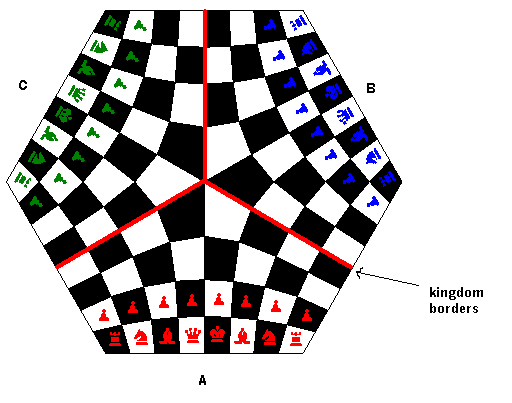Three-handed Chess
by Jonathan Rutherford
To start off, my game is obviously designed for three players. Unfortunately, as Schmittberger pointed out in his New Rules for Classic Games, most 3 player games of pure strategy suffer from some sort of unfairness. For instance, it is near impossible to play without two players picking on the third. They both may be weaker in some way and have to defeat the third in order to survive themselves. Or they may both be stronger and want to eliminate any complicating factors before duking it out themselves.
I therefore attempted to create a solution to the "petty diplomacy problem." Here, then, is my three-player chess, with special rules and the logic behind them.
The initial setup is as follows (graphics taken from Yalta description on Hans Boedlander's page, with minor alteration):

It is assumed that the reader is already familiar with the FIDE rules of chess. Most of the rules are the same, including piece movement, castling, en passant, etc. Play proceeds in a counter-clockwise fashion, starting with player "A."
As can be noted in the picture, the heavy red lines separate the three players' "kingdoms." These play an important role in special rules of movement.
In general, each player will attack the player to his right. This means he may near-freely cross the borders to his right without any change of rules. To the left, a player generally defends from the left player, and will usually not wish to cross to the left.
Should a player cross the border to his left, the left player is considered to doubly-attacked and gains new advantages. To better illustrate, say player "C" has just finished his turn, and player "A," instead of attacking player "B," attacks C. Player C is now attacked by player A (because he crossed the border to the left) as well as B (who normally would attack C). Player C could also get doubly attacked if he gets checked from player A, even though A may still be in his own kingdom.
When player C is doubly-attacked, you could say he gains a sort of "home-field advantage." He is now able to, but need not, make two moves per turn, subject to the following rules:
- he may move a piece within his boundaries twice (however if the first move brings the piece outside the boundaries, it cannot move a second time)
- he may move two pieces within his boundaries, once each
- he may move one piece within his boundaries once and one outside his boundaries once
- he may move only one piece, regardless of board position (he still must move a piece and may not pass his turn)
- his king may only move once per turn, regardless of position
These rules remain in effect until the imposing piece is removed, either by
capture or by the owner. Only one player may be attacked from both sides at a time. Therefore, player C could only take offensive action against player A, until the imposing piece is removed. Then, if any player desires, he may attack to the left.
Note: As long as the final position is legal, the doubly attacked player could create a self-check. For instance, he could move his king into check by a bishop, but in the second part of his move, block it with his knight.
In the case of the center diagonal, a player moving through it must always take the path between his kingdom and the kingdom to his right (i.e. he may only cross the border he normally could cross anyway).
A player wins by capturing one king. It must be through checkmate, though. A player has to move out of check if he can. If a player is checkmated or stalemated, his turn must pass. He may be released, though, by the third player by capturing the mating piece. Remember, mate must be followed through with the king's capture, and one king's demise ends the game, so the third player would probably prefer to keep the game going if possible so he could win. Both the mated player and the non-mating player lose.
Logical viewpoint: The reason for my set of rules is so that two players will seldom want to pick on the third, as will likely be able to parry most threats by both. However, with well coordinated forces, they could still pull off some sort of advantage in material, so alliances can help when used carefully. But, alliances are risky as well, since only one player wins, and you wouldn't want to help another player too much, lest you lose to him. In the end, every man is looking out for himself.
I hope these rules are clear and workable. Though I've thought of this game for 4 years before finally settling on these rules, I haven't actually been able to test them with anyone willing. It's almost impossible to make a three-player chess game without interaction on all three parts and a disadvantage for one. My game, I believe, has overcome these disadvantages, but still encourages limited diplomacy, which I feel could add to the skill required, and add caution so no player ignores potential threats from both sides.
If some of these rules are found to be useless, they may be dispensed at the player's discretion. If one prefers, a game may continue after one player is defeated, but I believe this reduces the fairness, as one player will likely be down in material. Also, if players prefer, they may have a cut-throat game, with every man for himself. Of course this is the least fair, but hey, it's fun if not taken too seriously.
Buy Equipment for this Game

